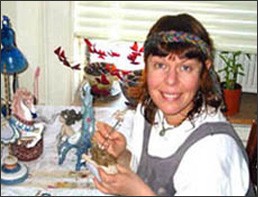Lladro Figurines are the greatest possessions not only to those who have taste and artistic disposition, but also to those who are interested in the culture and arts of Spain. More than half-a-century after the Lladro brothers opened their first shop in Valencia, Spain, Lladro figurines continue to be at the top of the list for most international fine art and craft dealers. As many collect rare stamps and paintings as a hobby these Lladro pieces also fill various shelves and showcases today. They are among the finest of porcelain figures to be found.
The origin of Lladro figurines date back to 1953 in Spain where three brothers worked on three basic elements such as earth, fire and color, which, coupled with their unique imagination and refined artistic tastes, presented the world with such amazing decorative pieces. They brought about great changes gradually in their methods of working, which finally resulted in a crystalline finish of the figurines that is unique to Lladro products found today.
All Lladro figurines are hand sculpted, painted and glazed to perfection. Although the figurines are made of hard-paste porcelain, they still need great care when handling as they are very dainty and fragile. If cracks do appear or they break completely, repair work would be needed to fix the broken Lladro.
The Essential Elements of Lladro Figurines Restoration
The first point to note is that it is essential to keep these porcelain figurines protected from all environmental harm and other damages. Dusting and cleaning them regularly with a mild soap and luke warm water is necessary. They should be wiped dry with a soft material in order to retain their shine and brightness.
Lladro figurines should be kept in a safe place out of reach of children. Display shelves and china cabinets are the best options in which to exhibit them. Harsh chemicals should never be used on them as they are harmful and may tarnish the surface of the figurine. As they are extremely delicate, careful handling must be adhered to at all times. Even though repair and restoration can take place it’s very important to protect and look after these figurines on a daily basis.
Lladro Restoration: The Process
There are a few unique methods of repairing and fixing broken Lladro pieces leaving the figurines as close to their original state as possible. These methods include:
Invisible Lladro Restoration:
This type of repair job leaves the figurine perfectly retouched and invisible to the naked eye. A restoration expert glues and bonds the broken parts together using a variety of adhesives, after which he or she matches the color and pattern/design of the figurine, replicates it using a paint brush and an airbrush, and finally glazes the surface of the figurine. It is always advised to seek professional services when undertaking such a repair job as it’s a very skilled and expensive task.
Re-bonding:
Re-bonding, also known as partial-restoration, is the least expensive method of professional restoration. Re-bonding involves the re-assembly of remaining pieces with no additional color restoration or design required for invisible repair.
Oriental Repair:
With this type of fixing, filled portions are refreshed with either a leaf of gold or viscous lacquer. Other decorative areas are not retouched.
Museum Repair:
The pieces are repaired and filled up first and then the colors are matched to the base or color of the body.
Note that of all the methods listed above, only the Invisible Lladro Restoration method reveals no traces of the repair. It is the most time consuming (three to four weeks) and most expensive method.
There are numerous Lladro figurines to be found in antique road shows, galleries, craft museums, private collections, the Web, etc., among them are valuable limited editions figurines that are worth quite a bit of money. Handling them with care will prevent much damage to these exclusive pieces and keep their value intact.


Speak Your Mind